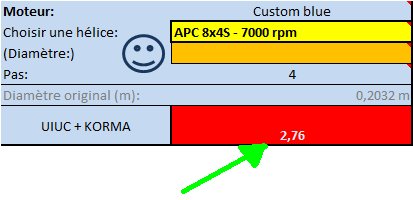Tetacalc - Pourquoi des tests d'hélices à différents Tr/min ?
C'est précisemment l'un des principaux sujets des tests menés par l'UIUC. Les performances des hélices de modélisme sont fortement impactées par la vitesse de rotation, et notamment par le nombre de Reynolds.
This is precisely one of the main subjects of the tests conducted by the UIUC. The performance of the RC propellers is strongly affected by the speed of rotation, and in particular by the Reynolds number.
Efficience à différentes vitesses de rotation de deux hélices 8x6 (source UIUC):
Efficiency at different speeds of rotation of two 8x6 propellers (UIUC source):
Où l'on peut voir l'intérêt des hélices "slow fly" à faibles tr/min.
Where we can see the interest of "slow fly" propellers at low rpm.
Dans Tetacalc, il est possible de vérifier la différence entre les tr/min du test et les tr/min calculés, ici:
In Tetacalc, it is possible to check the difference between the rpm of the test and the calculated rpm, here:
Ici, l'hélice a été testée à 7000 tr/min, mais Tetacalc calcule qu'avec le setup en cours elle tournera à 19340 tr/min, soit 2,76 fois plus vite.
Here, the propeller was tested at 7000 rpm, but Tetacalc calculates that with the current setup it will run at 19,340 rpm, so 2.76 times faster.

/image%2F1363385%2F20160517%2Fob_ff792f_trent.jpg)





/http%3A%2F%2Fg.rouby.free.fr%2FImages%2FJP1.jpg)
/http%3A%2F%2Fg.rouby.free.fr%2FTetacalc_tuto%2Faircraft1.jpg)
/http%3A%2F%2Fg.rouby.free.fr%2FTetacalc_tuto%2Fbatt1.jpg)
/http%3A%2F%2Fg.rouby.free.fr%2FImages%2F3vues_furax.jpg)
